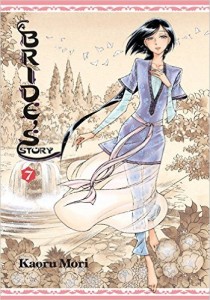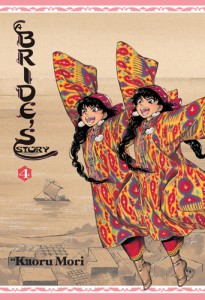By Kaoru Mori. Released in Japan as “Otoyomegatari” by Enterbrain, serialization ongoing in the magazine fellows!. Released in North America by Yen Press.
I have reached the point in this series where I genuinely do enjoy the adventures of Amir, Karluk, and their family, and I’m pleased to see we’ll be headed back there for Vol. 8. But I will admit that my top 3 volumes of this series have all been the ones that venture away from the ‘main’ characters and focus on English researcher Mr. Smith… or rather, focus on where he ends up in his travels, as he also barely figures in this volume. Instead, we get a different kind of wedding, as two already married wives with young children find each other and we are introduced to a marriage ceremony between two women who vow to be Avowed Sisters, a concept that reminds me of Anne Shirley’s bosom friends.
Our heroine this volume is Anis, a young merchant’s wife who is married to a caring husband and has a young child, but still feels there’s something lacking in her life – she *is* happy, but knows she could be happier. After talking with her maidservant, she decides to start going to the public baths, and there meets up with the shy Sherine, who is also married, and bonds with her immediate.y And by ‘bonds’, I mean ‘falls in love with’, as we see immediately that Anis is physically and emotionally attracted to the reserved Sherine. They bond really fast – something remarked on by everyone – and eventually agree to become Avowed Sisters, with a ceremony led by one of the female elders. Of course, this being a dramatic story rather than a history, the moment the ceremony is over, Sherine’s husband drops dead.
I’ve talked before about how most of Kaoru Mori’s titles deal with repressed emotions, and that’s true here as well, even though by comparison Anis is open and obvious. Sherine’s husband was poor, and with him now gone it’s clear that she may be reduced to begging. This leads to Anis asking her husband to take Sherine as a second wife – something acceptable in these times and places – and his stunned reaction. Her husband’s been presented as a good guy throughout, who has trouble reading his wife but clearly loves her. He never took another wife as he was worried Anis wouldn’t like it, and Anis agrees that is absolutely true – except for Sherine. And so the volume ends with the two Avowed Sisters living together as co-wives, planning a trip, and feeding the birds by an ornamental pond.
The mood throughout is beautiful – after the last volume’s battles and deaths, Mori wanted to have a more peaceful story, though she jokes this just led to a lot of nudity. Indeed, the bath scenes take up a large part of the book, and there’s a fold-out color illustration with even more. For all that fashion is her first drawing love, Mori adores drawing the naked female form. But overall this is about Anis and Sherine, and another example of nontraditional brides in what is thought to be a very traditional period in time. It’s well worth your time.


